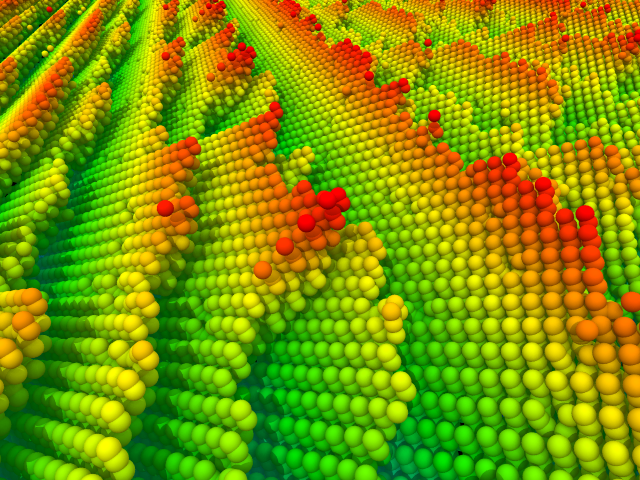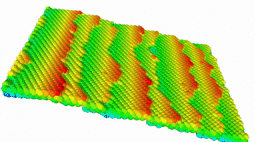Grain Boundary dynamics from atomistic calculations
The grain structure of a polycrystalline material is a primary determinant of its mechanical properties. Careful control of the evolution of this grain structure during the process of recrystallization is required if alloys are to be optimised for their intended engineering applications. If we are to develop accurate meso-scale models of microstrucutural evolution, we will need a good theoretical understanding of the mobility and migration mechanisms of grain boundaries.

The figure shows recent results on grain boundary migration. In contrast to previous assumptions the migration process must be captured fully in 3D, as the boundary migrates by addition of atoms to kink sites along roughened step edges. In the figure, only the lower grain is shown while atoms of the upper grain have been removed for clarity. The color indicates the height profile of the atoms. The direction normal to the grain boundary has been stretched to highlight the step structure.
The migration of grain boundaries in polycrystalline materials plays a crucial role in the evolution of microstructure in processing and application. A clear picture of how grain boundaries move is necessary for a full understanding of the mechanicalproperties of materials and will help enable the design of new materials to meet current technological challenges. Direct simulation of the evolution of the grain boundaries in a polycrystal under realistic conditions lies beyond the timescales achievable with atomistic simulation techniques such as classical molecular dynamics (MD). MD is thus frequently used rather as a tool to explore fundamental properties of isolated grain boundaries in bicrystals. These properties can then form inputs to larger length and time scale models. We have extensively studied general mixed tilt and twist grain boundaries in the vicinity of a [111] Σ7 symmetric tilt boundary in order to understand its migration mechanisms of grain boundaries of different plane orientations. Our results show differing migration kinetics and mechanisms involved for the studied boundaries. Figure 1 reveals a snapshot of motion for a general mixed grain boundary. Figure 2 shows an animation of the migration process for such a grain boundary.


